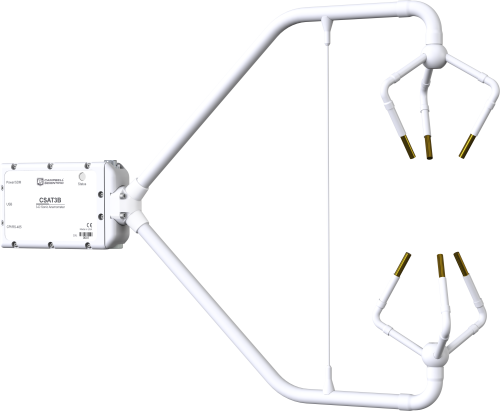
Product Line
| Measurement Description | Operating Temperature Range | Starting Threshold | Accuracy | |
|---|---|---|---|---|
05103-L
|
Wind speed and direction | -50° to +50°C (assuming non-riming conditions) |
|
|
CSAT3B
|
Highest-quality wind speed and direction | -40 to +50°C (equivalent to 305 to 368 m s-1 in speed of sound) | — | — |
CSAT3BH
|
Highest-quality wind speed and direction | -40 to +50°C (equivalent to 305 to 368 m s-1 in speed of sound) | — | — |
WINDSONIC4-L
|
Wind speed and direction | -35° to +70°C | — |
|
03002-L
|
Wind speed and direction | -50° to +50°C (assuming non-riming conditions) |
|
|
Other Considerations
| Measurement Description | Operating Temperature Range | Starting Threshold | Accuracy | |
|---|---|---|---|---|
05108-L40
|
Wind speed and direction | -50° to +60°C (assuming non-riming conditions) |
|
|
05108-45-L40
|
Wind speed and direction | -50° to +60°C (assuming non-riming conditions) |
|
|
05305-L
|
Wind speed and direction | -50° to +50°C (assuming non-riming conditions) |
|
|
WINDSONIC1-L
|
Wind speed and direction | -35° to +70°C | — |
|
03101-L
|
Wind speed | -50° to +50°C (assumes non-riming conditions) | 0.5 m/s (1.1 mph) | ±0.5 m/s (1.1 mph) |
27106T-L
|
Vertical wind speed | -50° to +50°C | — | — |
P2546D-L
|
Wind speed | Switching Characteristics: -40° to +60°C | < 0.3 m/s | — |
P2546A-L
|
Wind speed | Switching Characteristics: -35° to +60°C | < 0.4 m/s | — |
03301-L
|
Wind direction | -50° to +50°C (assuming non-riming conditions) |
|
±5° |
Related Documents
Product Brochures
FAQs for
Number of FAQs related to Wind Speed and Wind Direction Sensors: 4
Expand AllCollapse All
-
Sometimes, an old cable can be replaced with a new, shorter cable.
Sometimes, an existing cable can be shortened by cutting the ends off. However, there are a few issues that could be encountered when doing this:
- Some sensors have bridge completion resistors at the pigtail end.
- Some sensors are calibrated to length.
- Sometimes the color in the insulation may not be the same as that visible at the pigtail end.
Because of the potential issues, do not cut the ends off any sensor cable without first contacting Campbell Scientific to discuss the sensor in detail.
-
Whenever possible, purchase a sensor with the desired cable length. Some sensors have a user-specified cable length, whereas other sensors have a set cable length.
Sometimes, an old cable can be replaced with a new, longer cable.
Generally, additional cable cannot be spliced onto the existing cable because:
- Some sensor cables have bridge completion resistors at the pigtail end
- Some sensors are calibrated based on cable length
- Sometimes the color in the insulation is not the same as that visible at the pigtail end
- It is possible to introduce errors or malfunctions depending on the integrity of the splice
Splicing cable together increases the likelihood that water may enter the cable and cause shorting, corrosion, and some other potential issues, which in turn can cause measurement issues.
Because of the potential issues, do not splice any sensor cable without first contacting Campbell Scientific to discuss the sensor in detail.
-
Many times, but not always, a sensor’s cable can be replaced with a new cable. This is helpful if the original cable was damaged or if its length needs to be changed.
If the cable is attached to the sensor using a connector, Campbell Scientific will sell a replacement cable. For example, a 05106CBL-L is a replacement cable for a 05106-L. Replacement cables are listed in the “Replacement Parts” section of the Ordering information area of the product page.
If the cable is attached to a sensor through a user-accessible terminal block, a raw cable can be purchased to replace it. For example, to replace the cable on a 05103-L Wind Monitor, order the desired length of pn 9721, 24 AWG 3 Twisted Pair Shielded Santoprene Cable. As another example, the raw cable for a TE525-L Rain Gage is pn 9661, 22 AWG 1 Twisted Pair Shielded Santoprene Cable.
If the cable is an integral part of the sensor, the cable cannot be user replaced, and the sensor must be returned to Campbell Scientific. Some examples of sensors that fall into this category include the 107-L, 109SS-L, 229-L, CS547A-L, and CS650-L. For the process of returning equipment to Campbell Scientific, refer to the Repair and Calibration page.
-
Not every sensor comes with a calibration sheet. If a calibration sheet is included, it is listed in the “Ships With” section of the sensor’s product web page or it is specified when ordered.








